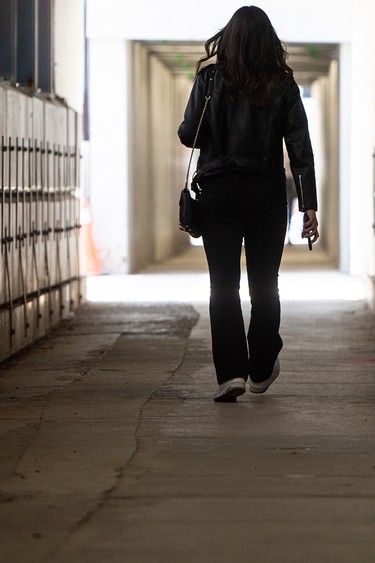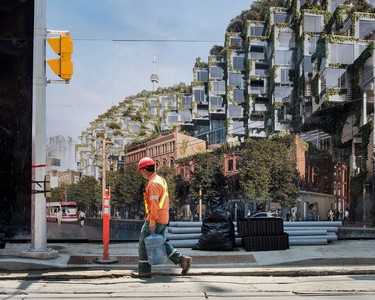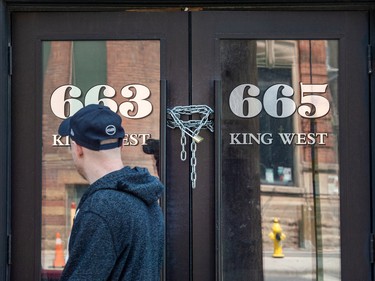Business recipe for success disrupted as downtown cores transform from places where people work and spend money to places where they don't do much of either

Article content
Karen Chapple was strolling near the University of Toronto’s downtown campus on a May afternoon, a sun-dappled splash of glory that arrived on the heels of a prolonged stretch of rainy weather. Some fire trucks passed nearby, sirens blaring, as the director of the university’s School of Cities made her way to a streetcar stop and cheerfully observed “lots of people” were out, brightened, no doubt, by that after-class, after-work glow that energizes urban environments.
Advertisement 2
Article content
It is a uniquely human energy, and the renewed hustle and bustle of city life has been echoed by recent statistics. For example, in-person work conferences are on the uptick, as the corporate traveller crowd seeks to reconnect with clients and woo new ones, according to a Deloitte study. Air Canada reports overall capacity on its flights has rebounded to about 90 per cent of pre-pandemic levels. And the trackers at CGA, a consumer research outfit, have found Canadians are heading out for drinks and good food again.
And why not? There is much to celebrate, including the World Health Organization declaring that the global health emergency triggered by COVID-19 is over. People are making up for lost time by returning to the everyday things we once normally did without a second thought, with one glaring exception: going to the office and hanging around nearby afterward.
Amid the overall trend to pre-pandemic normalcy, working from home remains a stubborn, post-pandemic reality. It is this new normal of not slugging it out in the cubicle from Monday to Friday that has radically, and perhaps permanently, transformed the downtown cores of major Canadian cities from places where people work and spend money to places where they don’t work so much and don’t spend money.
Advertisement 3
Article content
“People are going to sporting events, they are going to concerts, the festivals are coming back, there are students all over the place and there is a lot of visitor activity in downtown Toronto,” Chapple said. “But it is the worker segment of the downtown that remains extremely weak.”
How weak? Chapple and her colleagues use cellphone data to compare current levels of activity — that is, the number of people downtown on a given day — to pre-pandemic levels. Some North American urban cores have come roaring back to life or even been reinvented altogether as post-COVID-19 boomtowns. For example, Salt Lake City’s activity level is at 139 per cent of what it was in 2019. But Toronto, Ottawa, Vancouver, Montreal, Edmonton and Calgary are all treading water around 50 per cent.
Article content

That’s a lot of missing people, and it’s a wrinkle in a hypothesized, post-pandemic downtown recovery that has caught Chapple by surprise. She and her team predicted the numbers in Toronto would zoom back to 70 per cent, though they are now looking quite “stuck.”
The chief culprits appear to be commute times — Toronto scores among the worst in North America on that front — and the labour market. Unemployment is low and workers are in demand, but a lot of those folks are reluctant to come into the office. If one company starts twisting their arms to be at their desks, there is a chance the happy-at-home employee will quit and find work with some company that doesn’t care where they work from.
Article content
Advertisement 4
Article content
It is those people sitting at home, enjoying a peanut butter sandwich for lunch instead of meeting a buddy in the office tower next door for a quick, midday bite — or a round or two of beers at day’s end — that has imploded the pre-pandemic recipe for success for downtown business owners.
“It has kind of blown my brain, just how monumental the shift has been,” Glen Kristenbrun, a restaurant industry veteran, said.
Kristenbrun has restaurants in his blood. His father Tom owned a series of places over the years, including the El Mocambo, a landmark nightclub where the Rolling Stones played a surprise gig in 1977 (now immortalized on vinyl), and Bistro 990, a favourite haunt of the Toronto International Film Festival glitterati.
It has kind of blown my brain, just how monumental the shift has been
Glen Kristenbrun
But the younger Kristenbrun’s bread and butter turned out to be bacon and eggs. He once owned Over Easy, which was directly across the street from the Royal Ontario Museum. Above it was a gastropub he also owned. There was also a second breakfast place downtown, right around the corner from the Hockey Hall of Fame. The money was good.
“It was a captive audience,” he said.
Kristenbrun drew his customers from a mix of tourists, seniors taking the grandkids out for breakfast and the business crowd who worked in nearby buildings. He ultimately shuttered his places during the pandemic to spend time with his family, but he has lately been getting an itch to get back in the game.
Advertisement 5
Article content
However, the rules he once knew to be true are in flux, and quite possibly irrevocably changed.
“It is a real head-scratcher now, because you can’t go back to that friendly construct you once knew,” he said. “The people in the offices are only coming in one, maybe two days a week.”

The proof can be found in office vacancy rates. Despite near-record low unemployment rates across the country, Vancouver’s downtown office vacancy rate is sitting at 10.4 per cent, the highest it has been since 2004, while Ottawa (13.2 per cent) and Montreal (16.5 per cent) rates are at their highest points ever. And Toronto, the country’s largest office market and once renowned for having fully leased buildings, has a downtown office vacancy rate of 15.3 per cent, a level unseen since 1995.
Kristenbrun isn’t the only one scratching his head about what happens next. Erik Joyal, president of the Ascari Hospitality Group, is also a restauranteur with a winning track record who suffered a crushing defeat during the pandemic.
Eight months before the world shut down in March 2020, he and his partners opened Ascari Enoteca, an Italian restaurant on King Street West, on the periphery of Toronto’s downtown core. At the very best of times, opening a restaurant is a significant gamble, but in those heady days prior to the world going sideways, the location “ticked all the boxes,” Joyal said.
Advertisement 6
Article content
One of the key checkmarks was daytime traffic. Tech and advertising firms, startups, all the “cool kids” had office spaces in the area, while the more traditional suits in the banking towers were a short hop away. The area was jumping, with both a lunch and a dinner crowd to pull in. The new restaurant took off until, well, you know.
“Today, if you walk down King Street on a Tuesday afternoon, you could fire a cannon and nobody would notice,” Joyal said. “The day traffic is not there at all.”
Article content

Some of that traffic, he said, has migrated to their friendly home neighbourhood restaurants that, pre-pandemic, only used to be open for dinner, but now have enough work-from-homers nearby to open at 11:30 a.m.
Neighbourhoods, however, have a low saturation point since there are only so many beloved local establishments the locals can prop up. Operating downtown previously offered that most-sought-after thing: volume.
Apart from the geography, Joyal said there has been a seismic shift in the industry over the past three years. The line cook who worked to the bone on the way up the kitchen staff ladder in 2019 doesn’t want to work in restaurants anymore. Servers have left in droves. Morale is hovering around the point of despair, while food inflation and labour costs have dramatically driven up the price of doing business.
Advertisement 7
Article content
It is enough to make a successful restaurant guy want to throw in the towel, but Joyal hasn’t given up hope — he has two East End Toronto locations and a catering business — and he isn’t prepared to completely forsake the downtown core as a place to operate, but he’ll only jump back in if the conditions are “right.”
For now, the conditions seem, well, kind of weird, caught in a curious middle ground between the way things were in the olden days and the way things are now. But count Larry Plummer, who teaches entrepreneurship at Western University’s Ivey School of Business, among the workers-will-come-back crowd.

He has no data to draw from, but, in his heart of business hearts, he can’t let go of the image of a boardroom full of whiteboards and people brainstorming ideas, eating pizza and getting things done in an environment charged with creativity that simply can’t be replicated on a Zoom call.
Apart from gut feelings, Plummer said there is concrete value to organizations having a bricks-and-mortar office with people in them on a regular basis, particularly for companies on the hunt for private-equity and venture-capital funding.
“It is really hard to raise money when you are a virtual organization,” he said. “Investors want to be able to monitor their investment, and you can go through the history of stupid behaviour, of people taking money from an investor and using it to buy gold toilets or whatever, so investors want to have a place that they can walk in to unannounced to ensure you are using the money the way you said you would.”
Advertisement 8
Article content
Plummer was speaking from the business school’s offices on the 24th floor of First Canadian Place. Looking down on the Toronto streetscape below at 4:30 p.m. on a Wednesday, he counted a handful of pedestrians in place of the horde who would have been there at the same hour a few years ago.
Further uptown, Karen Chapple stood waiting for the streetcar. The sound of sirens had faded and in the quiet, she imagined a replenished core awash with people in a city anchored by its waterfront, a mix of businesses and residents, and good old Monday-to-Friday life buzzing around the streets.
“You have this great push to work from home, and so it really is a new normal,” she said. “But downtown is still an area with extremely high land values, real estate prices and global demand — and a million new immigrants coming — so it is not like it is going to be an urban doom loop for downtown. Something new and wonderful is going to come; we just don’t know what that is yet.”
Or when it will arrive.
• Email: joconnor@nationalpost.com | Twitter: oconnorwrites
https://ift.tt/X4Y2D50
Business
Bagikan Berita Ini














Comments
Postmedia is committed to maintaining a lively but civil forum for discussion and encourage all readers to share their views on our articles. Comments may take up to an hour for moderation before appearing on the site. We ask you to keep your comments relevant and respectful. We have enabled email notifications—you will now receive an email if you receive a reply to your comment, there is an update to a comment thread you follow or if a user you follow comments. Visit our Community Guidelines for more information and details on how to adjust your email settings.
Join the Conversation